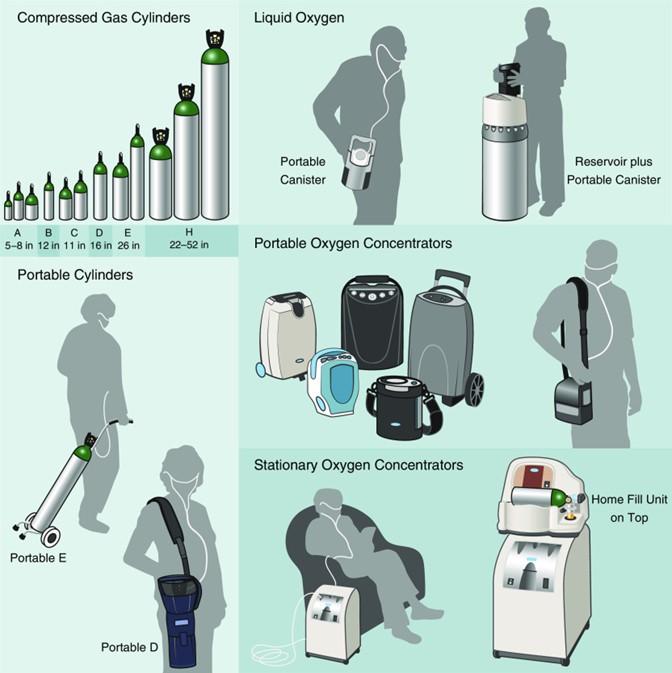[NOTE: This article has been posted prior to peer review for use in an active research program. This content will be updated with a peer reviewed version as soon as it is available.]
Ambulatory oxygen is oxygen that is prescribed for patients with COPD to be used while they are on the move, including doing chores around the house, activities of daily living, or walking. For patients who have a decline in oxygen saturation levels to less than 88%, or exertional hypoxemia, the recommendation from the American Thoracic Society is to engage in shared decision making. 1 This is based on a review of several studies that examined the use of oxygen in individuals who have isolated exertional hypoxemia, that is, a drop in oxygen levels to <88%. Studies that potentially support use of ambulatory oxygen from a quality-of-life perspective in this population include a meta-analysis of three studies found improvement in the dyspnea-related domain of the Chronic Respiratory Disease Questionnaire (standardized mean difference of 0.42 95% CI 0.04 – 0.79).2 However the 0.42 difference was lower than the minimally clinical important difference for the dyspnea domain of the CRQ. Another study found a significant difference in the SF-36 comparing the supplemental oxygen versus no supplemental oxygen group,3 but a separate study did not find a quality of life benefit measured using the SGRQ.4
Oxygen use has been shown to increase exercise capacity during specific clinic tests. Use of supplemental oxygen during exercise in patients with isolated exertional desaturation has resulted in an increase in exercise endurance by 5.8 minutes on a cycle ergometer5 and distance walked during six-minute walk tests.6 However, data has not been reported about the use of oxygen to improve the ability to perform physical activities encountered during day to day living.6
Because of these mixed results, for the group of patients with isolated exertional desaturation, shared decision making is encouraged between the physician and patient. This should include a discussion of the potential burdens of oxygen therapy including inconvenience, discomfort, being tethered to an oxygen source, and bulky devices.7
On the other hand, supplemental oxygen is recommended for all individuals with resting hypoxemia, defined by having an oxygen saturation of less than 88% when measured by a pulse oximeter. In these individuals, wearing oxygen throughout the day (known as long term oxygen therapy), has been shown to increase survival.8 Supplemental oxygen is recommended to be used for >15 hours a day, and having ambulatory (portable) oxygen while doing activities such as exercising can help meet that goal.9
References
- Erratum: Home Oxygen Therapy for Adults with Chronic Lung Disease. An Official American Thoracic Society Clinical Practice Guideline. Am J Respir Crit Care Med. Apr 15 2021;203(8):1045-1046. doi:10.1164/rccm.v203erratum7
- Faraone SV. Interpreting estimates of treatment effects: implications for managed care. P T. Dec 2008;33(12):700-11.
- Eaton T, Garrett JE, Young P, et al. Ambulatory oxygen improves quality of life of COPD patients: a randomised controlled study. Eur Respir J. Aug 2002;20(2):306-12. doi:10.1183/09031936.02.00301002
- Nonoyama ML, Brooks D, Guyatt GH, Goldstein RS. Effect of oxygen on health quality of life in patients with chronic obstructive pulmonary disease with transient exertional hypoxemia. Am J Respir Crit Care Med. Aug 15 2007;176(4):343-9. doi:10.1164/rccm.200702-308OC
- Porszasz J, Cao R, Morishige R, van Eykern LA, Stenzler A, Casaburi R. Physiologic effects of an ambulatory ventilation system in chronic obstructive pulmonary disease. Am J Respir Crit Care Med. Aug 1 2013;188(3):334-42. doi:10.1164/rccm.201210-1773OC
- Jacobs SS, Krishnan JA, Lederer DJ, et al. Home Oxygen Therapy for Adults with Chronic Lung Disease. An Official American Thoracic Society Clinical Practice Guideline. Am J Respir Crit Care Med. Nov 15 2020;202(10):e121-e141. doi:10.1164/rccm.202009-3608ST
- Croxton TL, Bailey WC. Long-term oxygen treatment in chronic obstructive pulmonary disease: recommendations for future research: an NHLBI workshop report. Am J Respir Crit Care Med. Aug 15 2006;174(4):373-8. doi:10.1164/rccm.200507-1161WS
- Cranston JM, Crockett AJ, Moss JR, Alpers JH. Domiciliary oxygen for chronic obstructive pulmonary disease. Cochrane Database Syst Rev. Oct 19 2005;2005(4):CD001744. doi:10.1002/14651858.CD001744.pub2
- Petty TL, Bliss PL. Ambulatory oxygen therapy, exercise, and survival with advanced chronic obstructive pulmonary disease (the Nocturnal Oxygen Therapy Trial revisited). Respir Care. Feb 2000;45(2):204-11; discussion 211-3.

